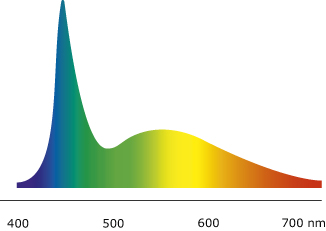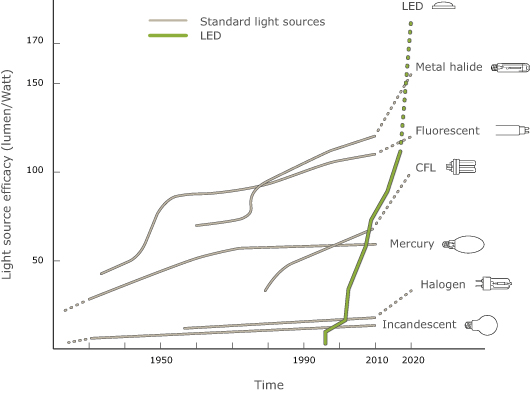LED Basics
A Light Emitting Diode (LED) generates light in a semi-conductor material, which is an electronic component. Using the right materials, a diode may produce visible light of various wavelengths.
White light is created by either using a blue diode or “chip” and adding yellow phosphor on top, or by mixing light from one red, one green and one blue diode (RGB). The use of phosphor conversion is the most commonly used method in the lighting industry, due to its high efficacy and flexible production method. The phosphor can be added directly onto each diode, or as a remote phosphor plate on top of a mixing chamber. This method creates a particular color spectrum or spectral power distribution for the LED depending on the phosphor layer.
LED is not a new invention and most of us are familiar with LEDs being the red or green signal markers on your Wi-Fi or television. These are referred to as low-power LEDs. During the last couple of years “high power” LEDs, i.e. LEDs operating at powers of around 1W, have reached a level of cost and performance that make them attractive to the general lighting industry.
Market studies forecast that in 2020, nearly 50% of all new and replacement lightsource unit sales will be based on LEDs. Since LEDs are more expensive than conventional lighting, the value of the LED sales will be even higher.
Currently, LED lightsource efficacy levels are around 160 lm/W (lumens per watt) compared to a compact fluorescent lightsource which produces an average of 50-70 lm/W. The LED itself is expected to yield around 200 lm/W within the next ten years (Sources: McKinsey and Osram).

The spectral power distribution (the amount of light emitted at each wavelength) of the LED incorporates the blue light from the chip and the yellow phosphor.

The chart above illustrates the development in efficacy (lm/W) over time for conventional and LED lightsources. Whereas fluorescent tubes are expected to reach a maximum of 120 lm/W in 2020, LEDs may reach around 200 lm/W. (Source: Osram)